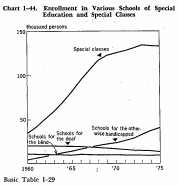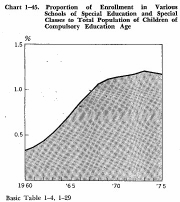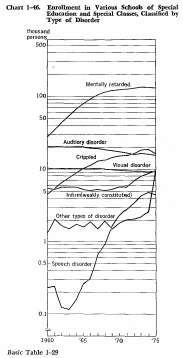| Home > Policy > White Paper, Notice, Announcement > White Paper > EDUCATIONAL STANDARDS IN JAPAN 1975 > CHAPTER1 5 | ||
Institutions of special education are such schools as the schools for the blind, schools for the deaf, and schools for the otherwise handicapped, as well as the special classes instituted in elementary and lower secondary schools. Various measures for expansion and improvement of these institutions have been taken with a view to ensuring the mentally and physically handicapped the opportunity of special education which they deserve. As regards schools for the otherwise handicapped and special classes in particular, expansion programs have been undertaken systematically, with a marked increase shown in enrollment.
Enrollment in these schools totaled 196,000 persons in 1975, including 9,000 in schools for the blind, 14,000 in schools for the deaf, 41,000 in schools for the otherwise handicapped, and 132,000 in the special classes of elementary and lower secondary schools. A slow decline is discernible in the enrollment in schools for the blind and schools for the deaf, while outstanding growth is shown in the enrollment in schools for the otherwise handicapped and special classes. During the last 15 years, enrollment in schools for the otherwise handicapped and in the special classes jumped 8.5 times and 3.8 times respectively. Paralleling this, the proportion of pupils enrolled in various special education schools and special classes to the total population of children of compulsory education age also climbed from 0.7% in 1960 to 1.2% in 1975.



As for the number of pupils receiving special education, classified by the type of disorder, the mentally retarded is the largest at 131,000 persons (135,000 including the mentally retarded belonging to the multihandicapped), accounting for two-thirds of the total. Next come the crippled, pupils with auditory disorders, etc. As for transition in enrollment, classified by type of disorders, those with visual disorders and those with auditory disorders are on a graual decrease, while a noticeable increase has been shown in the number of the mentally retarded, the crippled and those with speech disorders. Also, the number of the infirm (weakly constituted) pupils has been turning upward since 1965.
While it was previously pointed out that the number of children temporarily or permanently exempted from the obligation of attending schools has been dwindling yearly in line with expansion and improvement of the schools for the otherwise handicapped and special classes, a considerable number of pupils "requiring special educational treatment" due to mental and physical disorders are conceivably still enrolled in ordinary classes and receiving the same education as provided to ordinary pupils. In addition, the system of making compulsory the establishment of schools for the otherwise handicapped and handicapped children's enrollment in those schools, which had been left pending since the School Education Law was enacted, is scheduled for implementation on April 1, 1979.
| Back to Top | MEXT HOME |